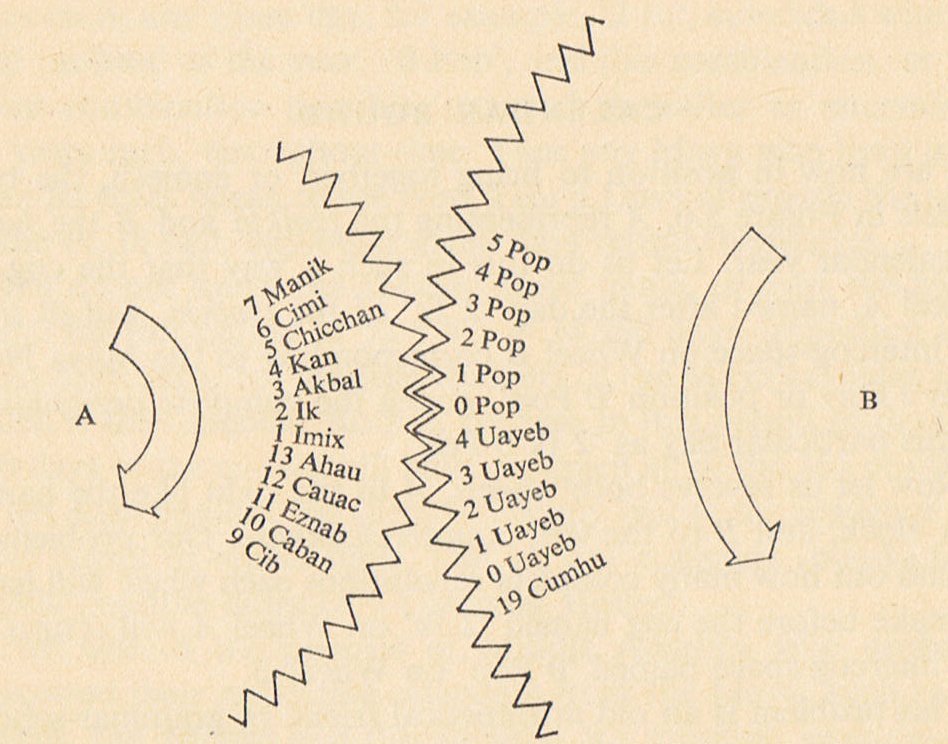The beginning of line Cb2 has glyphs which resemble those we saw earlier, before the murky week and the following 24 (Cb1-24) - 11 (Cb1-11) = 13 days:
Cb2-3 is the 8th and last honu glyph in this sequence:
From the 1st turtle in *Ca14-18 (381) up to and including the 8th and last hono huki in Cb2-3 (419), there are 419 - 381 + 1 = 39 (= 3 * 13) glyphs. Not only the Mayas used 13-day cycles:
The Arabs had 13 days as the norm in their manazil (Mansions of the Moon) structure, we should remember:
Furthermore, I have suggested heliacal Sheratan should be at *Ca14-27, which is glyph 390 (= 30 * 13) on side a.
My list of Polynesian words is short and inadequate. I therefore decided to see if I could find out what hono might mean. In William Churchill's Rapanui-English Vocabulary hono is defined as follows: "Honohono to join, to fit, to adjust, to unite, to patch, joint. Hakahonohono a joining. P Mgv.: hono, to join or fit pieces of wood together, to piece out a substance with another piece of the same material. Ta.: hono, to join, to unite." Metoro probably pointed out that Alcyone in the Pleiades was the junction between one cycle (of generations) and the next.
... We often see the assertion that our title is in no way connected with Άλκυών, the Halcyon, that 'symbolic or mystical bird, early identified with the Kingfisher', the ornithological Alcedo or Ceryle; so that although the myth of the Halcyon Days, that 'clement and temperate time, the nurse of the beautiful Halcyon', When birds of calm sit brooding on the charmed wave, is not yet understood, some of Thompson's conjectures as to its stellar aspect will be found interesting. He writes that the story originally referred to some astronomical phenomenon, probably in connexion with the Pleiades, of which constellation Alcyone is the principal star. In what appears to have been the most vigorous period of ancient astronomy (not later than 2000 B.C., but continuing long afterwards to influence legend and nomenclature) the sun rose at the vernal equinox, in conjunction with the Pleiad, in the sign Taurus: the Pleiad is in many languages associated with bird-names ... and I am inclined to take the bird on the bull's back in coins of Eretria, Dicaea, and Thurii for the associated constellation of the Pleiad ... Suidas definitely asserts that the Pleiades were called Άλκυόνες. At the winter solstice, in the same ancient epoch, the Pleiad culminated at nightfall in mid-heaven ... This culmination, between three and four months after the heliacal rising of the Pleiad in Autumn, was, I conjecture, symbolized as the nesting of the Halcyon. Owing to the antiquity and corruption of the legend, it is impossible to hazard more than a conjecture; but that the phenomenon was in some form an astronomic one I have no doubt. ... It culminates on the 31st of December ... (Allen) ... As soon as one has mastered the elementary grammar and accidence of myth, and built up a small vocabulary, and learned to distinguish seasonal myths from historical and iconotropic myths, one is surprised how close to the surface lie the explanations, lost since pre-Homeric times, of legends that are still religiously conserved as part of our European cultural inheritance. For example, the various legends of the halcyon, or kingfisher which like the wren, is associated in Greek myth with the winter solstice. There were fourteen 'halcyon days' in every year, seven of which fell before the winter solstice, seven after, peaceful days when the sea was smooth as a pond and the hen-halcyon built a floating nest and hatched out her young. According to Plutarch and Aelian, she had another habit, of carrying her dead mate on her back over the sea and mourning him with a peculiarly plaintive cry. The number fourteen is a moon-number, the days of the lucky first half of the month; so the legend (which has no foundation in natural history, because the halcyon does not build a nest at all but lays its eggs in holes by the waterside) evidently refers to the birth of the new sacred king, at the winter solstice - after his mother, the Moon-goddess, has conveyed the old king's corpse to a sepulchral island. Naturally, the winter solstice does not always coincide with the same phase of the moon, so 'every year' must be understood as 'every Great Year', at the close of which solar and lunar time were roughly syncronized and the sacred king's term ended ... Pliny, who carefully describes the halcyon's alleged nest - apparently the zoöphyte called halcyoneum by Linnaeus - reports that the halcyon is rarely seen and then only at the winter and summer solstices and at the setting of the Pleiades. This proves her to have originally been a manifestation of the Moon-goddess who was worshipped at the two solstices as the Goddess of alternatively Life-in-Death and Death-in-Life - and who early in November, when the Pleiades set, sent the sacred king his summons to death ... (The White Goddess) Probably Fakataka was the same as Hono - both indicating Alcyone (η Tauri): ... There is a couple residing in one place named Kui and Fakataka. After the couple stay together for a while Fakataka is pregnant. So they go away because they wish to go to another place - they go. The canoe goes and goes, the wind roars, the sea churns, the canoe sinks. Kui expires while Fakataka swims. Fakataka swims and swims, reaching another land. She goes there and stays on the upraised reef in the freshwater pools on the reef, and there delivers her child, a boy child. She gives him the name Taetagaloa. When the baby is born a golden plover flies over and alights upon the reef. (Kua fanau lā te pepe kae lele mai te tuli oi tū mai i te papa). And so the woman thus names various parts of the child beginning with the name 'the plover' (tuli): neck (tuliulu), elbow (tulilima), knee (tulivae) ...
|
|||||||||||||||||||||||||||||||||||||||||||||||||||||||||||||||||||||||||||||||||||||||||||||||||||||||||||||||||||||||||||||||||||||||||||||||||||||||||||||||||||||||||||||||||||||||||||||||||||||||||||||||||||||













